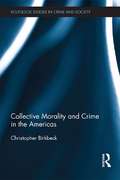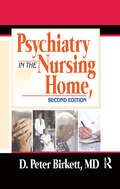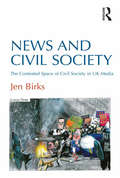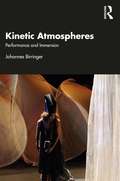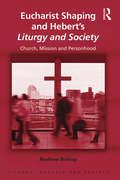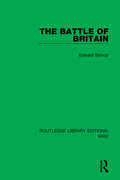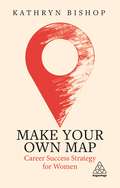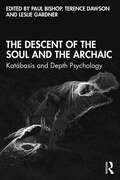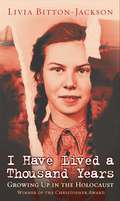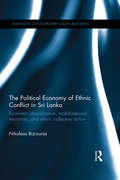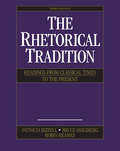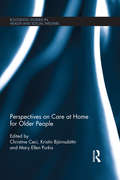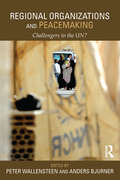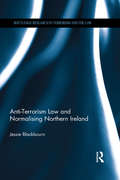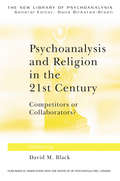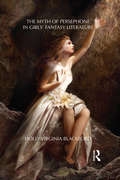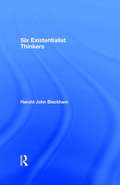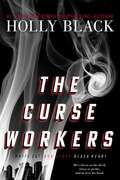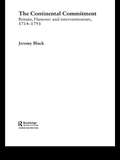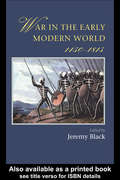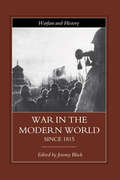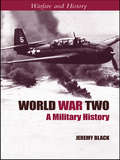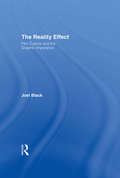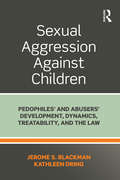Special Collections
Benetech’s Global Certified Accessible Titles
Description: Benetech’s GCA program is the first independent third-party EPUB certification to verify ebook accessibility. By creating content that is born accessible, publishers can meet the needs of all readers. Learn more: https://bornaccessible.benetech.org/
- Table View
- List View
Collective Morality and Crime in the Americas
by Christopher BirkbeckThis study examines the ways in which the moral community is "talked into being" in relation to crime, and the objects of concern that typically occupy its attention. It maps the imagined moral universe of the virtuous and the criminal and charts the relations between these two groups in the "history of the present." It examines the calls to action which symbolically endow the moral community with power. And it looks at the character and content of collective moralizing. The source materials are commentaries about crime and criminal justice appearing in selected newspapers across the Americas. The moral "talk" found there is stylized, routine, trivial and occasionally dramatic. It looks nothing like the weightier renderings of morality that derive from the reconstruction of a particular "ethic" or from the systematic probing of values and moral reasoning. And its fuzzy, offhand, unexceptional and frequently unsystematic nature makes it a difficult candidate for explaining either stability or change in crime policies. But moral talk has intrinsic importance as the creator and sustainer of an imagined moral community, a community that symbolizes the existence and vigor of morality itself and confers a crucially important identity on its self-proclaimed members. And moral talk reveals inherent intersections between normative, empirical and technical discourses, highlighting the relationships between morality, science and social engineering. Thus, a prosaic, instrumental, model of morality is particularly strong in North America, but only found in a more abstract form in Latin America, where it sits alongside a stirring vision of morality, more directly anchored in virtue. Research on social problems, moral panics and the sociology of morality has largely overlooked the type of moral discourse studied here. While emphasizing the culturally contingent nature of the findings, the conclusion reflects on their significance for understanding the nature of moralizing, the artifacts of talk and the construction of identity.
Psychiatry in the Nursing Home
by D. Peter BirkettGet the vital clinical information you need with this comprehensive handbook!In the decade since the first edition of this book, dramatic changes have taken place in the field of geriatric psychiatry. Psychiatry in the Nursing Home, Second Edition, presents timely information on the newest trends in law, culture, and medications, while still offering essential advice on the fundamental concerns of caring for elderly patients with mental illnesses. The new edition of this essential handbook presents up-to-date information on psychiatric issues involving nursing home patients. Featuring helpful case histories and diagnostic criteria, Psychiatry in the Nursing Home, Second Edition, helps you effectively treat such difficult problems as noisy patients, sexual acting out, and incontinence. In addition, it offers help with such administrative concerns as financial issues, absent or warring families, and staffing problems. Psychiatry in the Nursing Home, Second Edition, presents incisive discussions of the changes in the field since the publication of the first edition, including: the effects of the new Prospective Payment System the use of newly released psychotropic medications the altered nomenclature of the DSM-IV the rise in assisted-living facilities the rapid development of the specialty of geriatric psychiatry With its comprehensive scope and practical advice, Psychiatry in the Nursing Home, Second Edition, is a must-have for nursing-home administrators and staff. Policymakers, mental health professionals, and geriatricians will be fascinated by the book&’s wider considerations of the problems of housing and caring for the mentally ill and its provocative suggestions for future policy.
News and Civil Society
by Jen BirksCivil Society has not been more relevant as a concept and a practice since the fall of communism in Eastern Europe. Global events from Tahir Square to Wall St have brought a new relevance and urgency to questions about the boundaries of legitimate dissent and public order policing, the meaning of tolerance in the context of conflicting rights claims, and how we can agree on the shared values of the ’good society’. This timely book examines the representation of civil society in news media, exploring the popular understanding of this contested space in relation to conflicting legitimating frames: as the neo-liberal Big Society, activist political participation, or postmodern apolitical tolerance. With close reference to prominent news stories, including the UK state visit of Pope Benedict XVI, anti-austerity protests and industrial action, police infiltration of the environmental movement, and the Occupy camp at St Paul’s Cathedral in London, News and Civil Society scrutinises different facets of contemporary civil society, civility and civic virtue. A cross-disciplinary engagement with questions of national identity and pluralism, civil liberties and dissent, power and accountability, this book will appeal to those with interests in media, journalism, sociology, citizenship and political studies.
Kinetic Atmospheres
by Johannes BirringerThis book offers a sustained and deeply experiential pragmatic study of performance environments, here defined at unstable, emerging, and multisensational atmospheres, open to interactions and travels in augmented virtualities. Birringer’s writings challenge common assumptions about embodiment and the digital, exploring and refining artistic research into physical movement behavior, gesture, sensing perception, cognition, and trans-sensory hallucination. If landscapes are autobiographical, and atmospheres prompt us to enter blurred lines of a "forest knowledge," where light, shade, and darkness entangle us in foraging mediations of contaminated diversity, then such sensitization to elemental environments requires a focus on processual interaction. Provocative chapters probe various types of performance scenarios and immersive architectures of the real and the virtual. They break new ground in analyzing an extended choreographic – the building of hypersensorial scenographies that include a range of materialities as well as bodily and metabodily presences. Foregrounding his notion of kinetic atmospheres, the author intimates a technosomatic theory of dance, performance, and ritual processes, while engaging in a vivid cross-cultural dialogue with some of the leading digital and theatrical artists worldwide. This poetic meditation will be of great interest to students and scholars in theatre, performing arts as well as media arts practitioners, composers, programmers, and designers.
Eucharist Shaping and Hebert’s Liturgy and Society
by Andrew BishopThe contemporary Church of England is wrestling with issues around the relationship between its worship and mission and relating both to wider society. Much of this hinges on an understanding of the nature of the Church. Gabriel Hebert's seminal book Liturgy and Society (1935) took as its subtitle, "The Function of the Church in the Modern World". For many this book inspired engagement with Eucharistic worship, with new patterns emerging, paving the way for further liturgical reform in the second half of the twentieth century. Eucharist Shaping and Hebert's Liturgy and Society re-examines Hebert's work, doing so uniquely in the light of the current dialogue about Church, liturgy and mission. Andrew Bishop argues that Hebert's contribution has been overlooked latterly and that a re-appreciation opens up fruitful ways of thinking and acting, making this book a distinctive contribution to a lively debate. If the options are reaction or novelty, Eucharist Shaping and Hebert's Liturgy and Society shows how Hebert's thinking subtly undermines both.
The Battle of Britain
by Edward BishopThis book, first published in 1960, is a close examination of the twelve most decisive weeks in British history. It looks at the responsibility of pre-war politicians for the preparedness of the air defence system, the conflicting views on the conduct of the battle on both sides, the attitude of the US, and the part played by such leading figures as Dowding, Park, Beaverbrook, Kesselring and Sperle.
Make Your Own Map
by Kathryn BishopThere's no such thing as a pre-set path to career success. Following the footsteps of others can only get you so far - and for women, there are often additional obstacles. But what if you could design your own path to your career goals? What if you could Make Your Own Map?Based on material from the popular Women Transforming Leadership course from Saïd Business School, University of Oxford, Make Your Own Map will help you develop a resilient and aspirational strategy for your career - whatever your starting point. Effective methods of strategic planning have been tried and tested in the corporate business world, and this book shows you how to repurpose those methods for yourself, even if you're not in the corporate world. Packed with strategic tools and practical exercises, this book will help you: -Assess and define your career goals-Make a plan-Implement your plan to find the work that fits your needs, your skills, and your direction.With your best career as the goal, this book will help you forge your own path and Make Your Own Map.
The Descent of the Soul and the Archaic
by Terence Dawson and Leslie Gardner and Paul BishopThe Descent of the Soul and the Archaic explores the motif of kátabasis (a "descent" into an imaginal underworld) and the importance it held for writers from antiquity to the present, with an emphasis on its place in psychoanalytic theory. This collection of chapters builds on Jung’s insights into katabasis and nekyia as models for deep self-descent and the healing process which follows. The contributors explore ancient and modern notions of the self, as obtained through a "descent" to a deeper level of imaginal experience. With an awareness of the difficulties of applying contemporary psychological precepts to ancient times, the contributors explore various modes of self-formation as a process of discovery. Presented in three parts, the chapters assess contexts and texts, goddesses, and theoretical alternatives. This book will be of interest to scholars and analysts working in wide-ranging fields, including classical studies, all schools of psychoanalysis, especially Jung’s, and postmodern thought, especially the philosophy of Deleuze.
I Have Lived a Thousand Years
by Livia Bitton-JacksonWhat is death all about? What is life all about?
So wonders thirteen-year-old Elli Friedmann as she fights for her life in a Nazi concentration camp. A remarkable memoir, I Have Lived a Thousand Years is a story of cruelty and suffering, but at the same time a story of hope, faith, perseverance, and love. It wasn't long ago that Elli led a normal life that included family, friends, school, and thoughts about boys. A life in which Elli could lie and daydream for hours that she was a beautiful and elegant celebrated poet. But these adolescent daydreams quickly darken in March 1944, when the Nazis invade Hungary. First Elli can no longer attend school, have possessions, or talk to her neighbors. Then she and her family are forced to leave their house behind to move into a crowded ghetto, where privacy becomes a luxury of the past and food becomes a scarcity. Her strong will and faith allow Elli to manage and adjust, but what she doesn't know is that this is only the beginning. The worst is yet to come...
The Political Economy of Ethnic Conflict in Sri Lanka
by Nikolaos BiziourasAt the point of independence in 1948, Sri Lanka was projected to be a success story in the developing world. However, in July 1983 a violent ethnic conflict which pitted the Sinhalese against the Tamils began, and did not come to an end until 2009. This conflict led to nearly 50,000 combatant deaths and approximately 40,000 civilian deaths, as well as almost 1 million internally-displaced refugees and to the permanent migration abroad of nearly 130,000 civilians. With a focus on Sri Lanka, this book explores the political economy of ethnic conflict, and examines how rival political leaders are able to convince their ethnic group members to follow them into violent conflict. Specifically, it looks at how political leaders can influence and utilize changes in the level of economic liberalization in order to mobilize members of a certain ethnic group, and in the case of Sri Lanka, shows how ethnic mobilization drives can turn violent when minority ethnic groups are economically marginalized by the decisions that the majority ethnic group leaders make in order to stay in power. Taking a political economy approach to the conflict in Sri Lanka, this book is unique in its historical analysis and provides a longitudinal view of the evolution of both Tamil and Sinhalese ethnic drives. As such, this interdisciplinary study will be of interest to policy makers as well as academics in the field of South Asian studies, political science, sociology, development studies, political economy and security studies.
The Rhetorical Tradition
by Patricia Bizzell and Bruce Herzberg and Robin ReamesThe Rhetorical Tradition, the first comprehensive anthology of primary texts covering the history of rhetoric, examines rhetorical theory from classical antiquity through today. Extensive editorial support makes it an essential text for the beginning student as well as the professional scholar.
Reincarnation
by Joel BjorlingFirst Published in 1996. Routledge is an imprint of Taylor & Francis, an informa company.
Perspectives on Care at Home for Older People
by Christine Ceci and Kristín Björnsdóttir and Mary Ellen PurkisDemographic and epidemiological changes mean that frail older people have come to be seen as an expensive problem for health care systems. The challenge for professionals and policy-makers is to find ways to respond to the coming crisis by delivering high-quality care in the home. This collection offers a critical analysis of home care policy and practice. It focuses on how high-quality care is provided and the practices and policies that support this. It offers case studies (both policy- and practice-oriented empirical studies) from countries that share a basic orientation to social welfare: Canada, Denmark, Finland, Iceland, Sweden and the United Kingdom. The nine chapters set out a critical agenda for the development of "good" practices in challenging times. This book is essential reading for students, practitioners and researchers who wish to understand diverse problems in care provision for frail older persons and the complexities of policy responses in different health and social care contexts.
Regional Organizations and Peacemaking
by Peter Wallensteen and Anders BjurnerThis book analyses the new and difficult roles of regional organizations in peacemaking after the end of the Cold War and how they relate to the United Nations (UN). Regional organizations have taken an increasingly prominent role in international efforts to deal with international security. The book highlights the complex interaction between the regional and sub-regional organizations, on the one hand, and their relations with the United Nations, on the other. Thus, the general issues of UN and its authority are scrutinized from legal, practical and geopolitical perspectives. Taking on a broad geographical focus on Africa, the Arab world and Europe, the book also provides an extensive range of case studies, with detailed analysis of particular situations, organizations and armed conflicts. The authors scrutinise the heterogeneous relationship between the different organizations as well as the challenges to them: political resources, legal standing, financial assets, capabilities and organizational set up. Moreover, they investigate whether regional organizations, as compared to the UN, are better suited to deal with today’s intra-state conflicts. The book also aims to dissect the evolution of these institutions historically – in relation to Chapter VIII of the UN Charter which mentions the resort to 'regional arrangements’ for conflict management – as well as more generally in relation to the principles of international law and UN principles of peacemaking. This book, written by a mixture of established scholars, diplomats and high-level policymakers, will be of great interest to students as well as practitioners in the field of peace and conflict studies, regional security, international organisations, conflict management and IR in general.
Anti-Terrorism Law and Normalising Northern Ireland
by Jessie BlackbournThe Northern Ireland peace process has been heralded by those involved as a successful example of transformation from a violent conflict to a peaceful society. This book examines the implementation of the Belfast Agreement in Northern Ireland, and evaluates whether its goal to establish a normal, peaceful society has been fully realised. Using the political and legal status of England, Scotland and Wales as a comparison, Jessie Blackbourn evaluates eight aspects of Northern Ireland which the Agreement aimed to normalise: the contested constitutional status of Northern Ireland, the devolution of power, decommissioning, the removal of emergency laws, demilitarisation, police reform, criminal justice reform, and paramilitary prisoners. The book highlights the historical context which gave rise to the need for a programme of normalisation within the Belfast Agreement with respect to these areas and assesses the extent to which that programme of normalisation has been successfully implemented. By evaluating the implementation of the Belfast Agreement, the book demonstrates the difficulties that transitional or post-conflict states face in attempting to wind back extraordinary counter-terrorism policies after periods of violence have been brought to an end. The book will be of great use to students and researchers concerned with the emergence, evolution and repeal of anti-terrorism laws, and anyone interested in the history of the conflict and peace process in Northern Ireland.
Psychoanalysis and Religion in the 21st Century
by David M. BlackWhat can be gained from a dialogue between psychoanalysis and religion? Freud described religion as the universal obsessional neurosis, and uncompromisingly rejected it in favour of "science." Ever since, there has been the assumption that psychoanalysts are hostile to religion. Yet, from the beginning, individual analysts have questioned Freud's blanket rejection of religion. In this book, David Black brings together contributors from a wide range of schools and movements to discuss the issues. They bring a fresh perspective to the subject of religion and psychoanalysis, answering vital questions such as: How do religious stories carry (or distort) psychological truth? How do religions 'work', psychologically? What is the nature of religious experience? Are there parallels between psychoanalysis and particular religious traditions? Psychoanalysis and Religion in the 21st Century will be of great interest to psychoanalysts, psychoanalytic therapists, psychodynamic counsellors, and anyone interested in the issues surrounding psychoanalysis, religion, theology and spirituality.
The Myth of Persephone in Girls' Fantasy Literature
by Holly BlackfordIn this book, Blackford historicizes the appeal of the Persephone myth in the nineteenth century and traces figurations of Persephone, Demeter, and Hades throughout girls’ literature of the nineteenth and twentieth centuries. She illuminates developmental patterns and anxieties in E. T. A. Hoffmann’s Nutcracker and Mouse King, Louisa May Alcott’s Little Women, Emily Brontë’s Wuthering Heights, J. M. Barrie’s Peter and Wendy, Frances Hodgson Burnett’s The Secret Garden, E. B. White’s Charlotte’s Web, J. K. Rowling’s Harry Potter and the Chamber of Secrets, Stephenie Meyer’s Twilight, and Neil Gaiman’s Coraline. The story of the young goddess’s separation from her mother and abduction into the underworld is, at root, an expression of ambivalence about female development, expressed in the various Neverlands through which female protagonists cycle and negotiate a partial return to earth. The myth conveys the role of female development in the perpetuation and renewal of humankind, coordinating natural and cultural orders through a hieros gamos (fertility coupling) rite. Meanwhile, popular novels such as Twilight and Coraline are paradoxically fresh because they recycle goddesses from myths as old as the seasons. With this book, Blackford offers a consideration of how literature for the young squares with broader canons, how classics flexibly and uniquely speak through novels that enjoy broad appeal, and how female traditions are embedded in novels by both men and women.
Six Existentialist Thinkers
by Harold John BlackhamIncludes summary but substantial accounts of the thought of Kierkegaard, Nietzsche, Jaspers, Marcel, Heidegger and Sartre, and a concluding essay that attempts to interpret the whole Existentialist movement.
The Curse Workers
by Holly BlackFrom #1 New York Times bestselling author Holly Black comes the &“dangerously, darkly gorgeous&” (Cassandra Clare) Curse Workers trilogy, now together in one beautiful bind-up!Cassel Sharpe comes from a family of curse workers, people who have the power to change emotions, memories, and luck with the slightest touch of their hands. And since curse work is illegal, they&’re also all criminals. Many become mobsters and con artists, but not Cassel. He doesn&’t have magic, so he&’s an outsider, the straight kid in a crooked family—except for the small detail that he killed his best friend, Lila, three years ago. Cassel has carefully built up a facade of normalcy, blending into the crowd. But his facade starts to crumble when he finds himself sleepwalking, propelled into the night by terrifying dreams about a white cat that wants to tell him something. He&’s noticing other disturbing things, too, including the strange behavior of his two older brothers, who are keeping secrets from him. As Cassel begins to suspect he&’s an unwitting pawn in a huge con game, he must unravel his past, and his memories. To find the truth, Cassel will have to out-con the conmen. This magical bind-up includes: White Cat Red Glove Black Heart
The Continental Commitment
by Jeremy BlackRecent debates about British political and military strategies, derived in particular from dissension about Britain’s relationship with Europe and from disagreement over the Iraq war, has led to a greater awareness of the problematic nature of the concept of ‘national interests’. This major new work delivers a long view of this issue, its twin strands are captured by an assessment both of the Continental commitment and British interventionism in the 18th Century. The extent to which Britain’s rise to superpower status in America and Asia was related to the Continental connection, and her Hanoverian interests, is a central theme of this study, as is the relationship between the domestic position of the Crown and its interests as Electors of Hanover. The issue of Continental interventionism opens up the question of how alliances generate their own pressures, at the same time that they are supposed to help overcome challenges; while also indicating how the domestic support for alliances shifts, creating its own dynamics that in turn affect the international dimension. This book will be of great interest to students and scholars of international relations, British foreign policy, British history and war and conflict studies.
War In The Early Modern World
by Jeremy BlackA collection of essays charting the developments in military practice and warfare across the world in the early modern and modern periods.
War in the Modern World since 1815
by Jeremy BlackConflict is central to human history. It is often the cause, course and consequence of social, cultural and political change. Military history therefore has to be more than a technical analysis of armed conflict. War in the Modern World since 1815 addresses war as a cultural phenomenon, discusses its meaning in different socities and explores the various contexts of military action.
World War Two
by Jeremy BlackCutting through over half a century of historical build-up, this new and convincing account of World War II uses a global perspective to explain the complicated course in military terms. Black, a distinguished military historian , bucks the current trend to demilitarise and gives due weight to the campaigns and battles that made up the war. In doing so he challenges common interpretations and includes new insights to make this one of the most exciting new histories of the Second World War. Covering all the main areas of conflict, the chronological approach includes analysis of attacks at land, air and sea and a comparison of military resources. The focus is always operational, but social, cultural and political aspects are also included. Providing a crucial counterweight to previous histories, Jeremy Black's World War Two offers fresh insights into operations at the Eastern Front and during the war against Japan.
The Reality Effect
by Joel BlackIt used to be only movies were on film; now the whole world is. The most intimate and most banal moments of our lives are constantly recorded for public consumption. In The Reality Effect, Joel Black argues that the desire to make visible every aspect of our lives is an impulse derived from cinema- one that has made life both more graphic and less "real." He approaches film as a documentary medium that has obscured-if not obliterated- the line between reality and fiction. To illustrate this effect, Black traces the uncanny interplay between movies and real-life events through a series of comparative analyses-from Lolita and the murder of JonBenét Ramsey to Wag the Dog and the Clinton scandal to Crash and Princess Diana's violent death.
Sexual Aggression Against Children
by Jerome Blackman and Kathleen DringIn Sexual Aggression Against Children: Pedophiles’ and Abusers' Development, Dynamics, Treatability, and the Law, Drs. Blackman and Dring use multiple psychoanalytic principles to answer, “Why do people sexually abuse children?” and “Why are most abusers male”? They address the legal and mental health professions’ minimization of the horrific nature of child sexual abuse, explain how to assess pedophiles’ treatability, and discuss cases of adolescent and adult predators. Also, developmental analysis of sexual predation is integrated with a review of judicial decisions regarding civil commitment and punishment of abusers. The authors suggest how courts, evaluators, and legislatures can preserve constitutional rights of sexual offenders while prioritizing protection of children.
